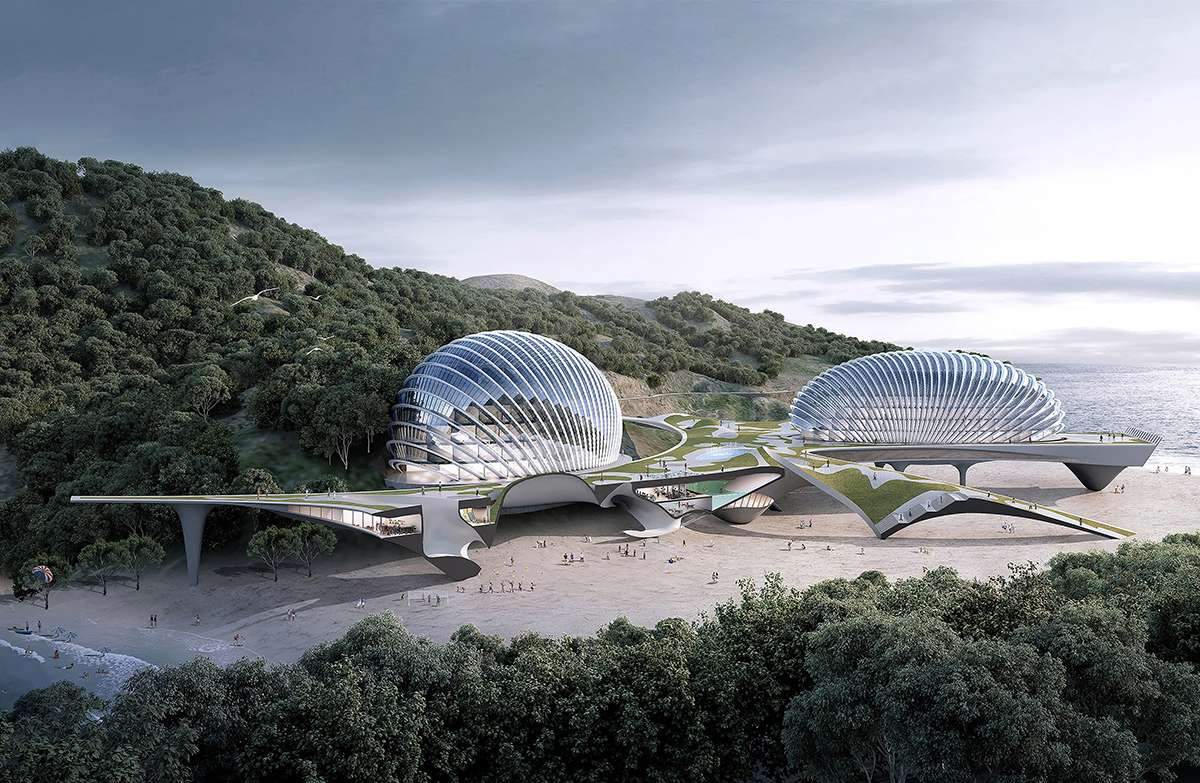Nudibranch Hotel with undulating sea creatures deck,
Architecture studio SpActrum has designed an undulating,
sandy-looking platform hotel inspired by the marine creatures of its island Nanji.
The new hotel, called Hotel Nudibranch, is designed to be an eco-friendly new landmark among sandy bays in Wenzhou, Zhejiang, China.
The design was proposed as a key part of the development of the international tourist island of Zhejiang,
which is located in the East China Sea.

Hotel design features
The architects designed a floating sand platform that blended into the hotel,
and a large outdoor playground that casts a shadow under the building above it.
The building consists of a hotel, playground, restaurants, bars, spa and swimming pool,
inspired by slugs and oysters, which lift themselves with their soft legs and extend their tentacles to explore different directions.
The team wanted the building to look like a public part of the hotel, like a space floating on sand.
The mollusk’s legs extend from the ground to connect visitors to the restaurants, bars, spa and swimming pool in the public space above.
There is a private garden above the public floor for hotel residents.
The hotel rooms are located in two shell-like buildings that offer beautiful sea views to most of the rooms.
The building eliminates the boundaries between it and the landscape through its organic form and flexible connection;
It lies on the site like a slug on the quiet bay.
The studio has also installed a lot of eco-friendly technologies to reduce the environmental impact on the site.

Hotel location
The hotel is located in the narrow part of the island, on a site that was completely covered with sand from the east to the west bays.
Through studies of the site, it is clear that it contained some small houses,
With the island development plan designed to promote tourism and geological protection, the design began to respond to this and improve the site.
The houses were removed and the site returned to a beach covered with sand from east to west, facing two bays on two sides, as it was in the past.
The elevated hotel partially covers the sand, giving shade to the tourists enjoying on the beach,
thus the hotel boundaries are set horizontally rather than the normal plot boundaries.
There are many ways in which the sandy ground relates to the common floor space and the platform above it,
in order to create different experiences.
The public floor extends into different parts of the site, the path passes through the building to embrace the West Bay and overlooks the East Bay,
then gently curves to match the hill to the north.

Hotel interior design
There are all kinds of function areas on the main floor, and there are some hills that rise from the public floor to the podium,
to build connectivity as well as visual connections and lighting.
The hotel rooms are placed in glass shells on top of the platform,
offering a wonderful view of the sea, and the building stretches from west to east, giving the best view of the sunrise and sunset.
The building is not just a facility to accommodate guests only,
but also acts as an amplifier to enhance their experience with nature.
Environmental concerns were the main goal of the design,
as they began to return the sandy bay to its natural place, and the organic forms contributed to its seamless integration with the environment.
The shade it casts on the beach makes the public spaces usable without air conditioning, in the heat of the summer sun.

The hotel as an eco-friendly building
In the beginning, the upper part of the public floor was equipped with rain harvesting devices to take advantage of its water,
and the double shells ventilate the hotel towers naturally, without the need to use air conditioning that contributes to harming the environment.
A biological waste processor is used to generate energy from garbage without having to burn it,
and the organic forms can inspire visitors to the island to explore the beauty and secrets of the sea.
The team of designers used parametric design technology from the beginning of the design process,
and the design of the public floor was completed using studies on traffic and site orientation,
to enhance the connection of roads from the mountain to the north and the beach.
The hotel’s glass envelope made the panels less reflective of the sun and the surrounding environment at the same time.
The development of the island will significantly improve public tourism facilities, at the same time while improving environmental standards.
The hotel’s unique design and design is the iconic symbol of this ambitious plan,
and is expected to be the diamond in the crown of Nanji Island.







